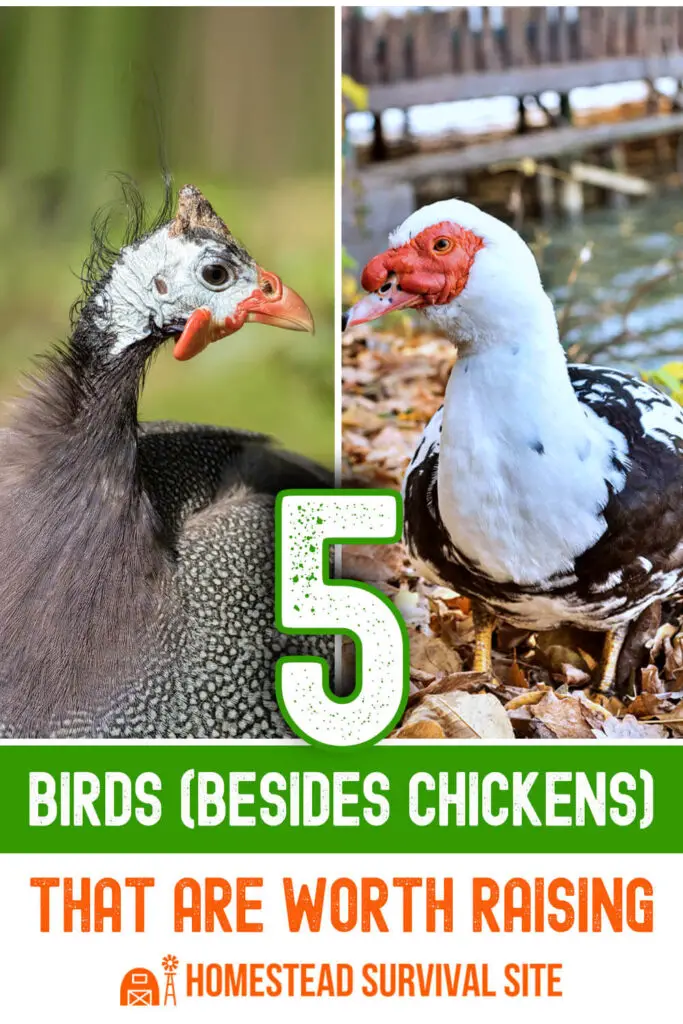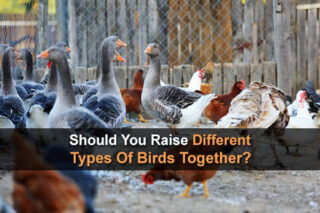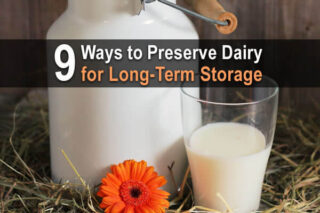Estimated reading time: 7 minutes
Though chickens are the best-known type of backyard poultry, there are many other breeds worth considering. A mixed flock has many advantages, as each type of bird will eat different forage rather than directly competing, meaning you can keep more birds in a single space without depleting resources.
If provided with ample forage and outdoor space, all of these birds can thrive on generic chicken feed rather than a specialty feed. Avoid using medicated chicken feed, as some medications can be harmful to different types of poultry and dosages vary with different types of fowl.
Want to save this post for later? Click Here to Pin It on Pinterest!
1. Ducks
While chickens are considered the “gateway animal” into homesteading, ducks aren’t far behind in popularity. Depending on your climate, ducks might actually be a better choice.
They tolerate humid and rainy weather better than chickens, making them especially well suited to the Northeast, South and Pacific Northwest. They’re also very cold hardy, and while chickens will spend the winter hiding in a coop, ducks prefer to spend the day outside and will “splash” in snow as if it were liquid water.
Many duck breeds lay as many eggs per year as a typical chicken, and females hatched in the spring will begin laying their first eggs in the late fall. Some specialty breeds, such as the Pekin duck, grow quickly and can be harvested for meat at as young as 8 weeks.
There are some important things to keep in mind when choosing ducks. Unlike chickens, they don’t roost or nest off the ground. If you’re converting chicken housing to duck housing, they’ll need ample floor space and ground nesting sites, and since they’re not roosting, they don’t mind low ceilings. A-frame shelters are particularly well suited, as they maximize ground space.
Ducks produce larger, richer eggs than chickens, and they have rich tasty meat, but that comes at a cost. They also tend to eat roughly twice as much as a chicken does each day.
2. Geese
Though they often have a bad reputation as being bullies, if hand raised from goslings, they imprint on their caretakers and become loving and devoted animals. It’s not uncommon to see a goose run out to excitedly greet their caretaker, going as fas as following you and rubbing their head and neck against your legs in the same way a cat does.
When raised in a mixed flock, this devotion extends to the other birds around them. Geese are excellent poultry protectors, and not only will they take on a neighborhood dog, but they’ll also intervene to break up fights between the other birds in their charge.
Keep in mind that geese have been bred as alarm birds, which is great if you live in a rural location without many visitors or traffic. In town, they’ll be sure to let you know anytime a car drives by which will have you (and your neighbors) planning for Christmas dinner early.
3. Turkey
If you’re looking to put meat on your table, a turkey is one of the best ways to do it. Turkey is flavorful lean meat that grows quickly, and most heritage breeds forage efficiently for a significant portion of their food. Believe it or not, it takes almost as much time to process and hand pluck a 5-pound chicken as it does a 25-pound turkey, making turkey a much more efficient way to fill your freezer.
Though turkeys don’t lay quite as many eggs as chickens per year, if you keep collecting them rather than letting the hens incubate them, it’s possible to harvest between 80 and 100 per year through the summer. While that’s less than half what you can expect from a chicken, they’re well worth it in terms of flavor. A turkey egg is reputed to be the most flavorful egg you can find.
4. Guinea Fowl
For the more adventurous poultry keeper, there’s always guinea fowl. There are few poultry that create such a split of opinion from their keepers. After keeping them for a season, people either love them and sing their praises or they hate them and can't get rid of them fast enough.
Whether or not you’re successful with guinea fowl greatly depends on the particular birds and your circumstances. If kept in the right conditions, they can be a productive addition to any domestic flock.
One of the best natural foragers, during the summer months feed is barely necessary if they’re given enough space. They’re primarily kept for their meat, which is considered a delicacy in many countries. Their eggs are also flavorful and rich, but often hard to find as they tend to hide them.
It may be a challenge to get them to stay in the coop as they often prefer to roost high up in the trees. If raised by hand from young keets and kept locked in during their youth, you can raise guinea fowl that are more domesticated than their semi-feral counterparts.
5. Muscovy Ducks
While they are called ducks, they’re technically their own species. If muscovies interbreed with regular ducks, their offspring will be sterile. For that reason, it’s recommended that you either keep regular ducks or muscovies, but not both species together.
If you’re raising for meat, muscovy ducks are a better bet. They’re large bodied and produce dark beefy meat, closer to goose meat than duck. They’re devoted mothers, and a hen can hatch and raise 20 or more chicks at once. That’s a lot of meat each season from a single hen. Some homesteaders skip on raising a beef cow and just keep a few productive muscovy hens around to supply enough ground duck “hamburger” for their family (you really might not taste the difference).
3 Birds Not to Raise
While all the birds above can be raised easily with chickens in a simple backyard or small homestead setup, there are plenty of others that require specialized care, feeding, and housing that aren’t worth bothering with unless you’re ready to take on the extra time and expense.
1. Peacock
While they’re showy and fun, peacocks require a lot of space to stretch out, at least 100 square feet per bird. They need high ceilings and large yards so they can display their tails for breeding. Both the males and females call constantly, and their high-pitched squeal won't let you have a moment’s peace.
2. Quail
Unless you’re really short on space, don’t bother with quail. While they’re cute and can be raised in a tiny rabbit hutch in your basement, it takes a lot of quail eggs to make an omelet. They need their own specialized housing, and can readily fly to escape if you’re not careful. They can be a great novelty for an urban homesteader, but if you have the space to raise even bantam chickens, choose them instead.
3. Emu
They can be devoted pets if hand raised, but after the first generation, you’re in for a world of trouble. Large enough to peck your eyes out or deliver a seriously damaging kick, these large birds can be dangerous. They require a huge amount of space to run and are more like keeping cattle than poultry. Emu oil can be profitable, but there’s a reason people don’t choose to raise them often.
Like this post? Don't forget to Pin It on Pinterest!













Great post, very informative! I had no idea geese, could be back yard animals!
We raised them on two occasions. They imprinted on us and were devoted pets. We had a rigid plastic childs wading pool we could dump and clean during the summer so they could splash about. They kept the fenced backyard mowed down. And no one jumped our fence to cut through our yard while they were there. Great watch dogs. You have to have two or more. One won’t make it alone.
I’d raise coturnix quail even if I had 100 acres. They’re fun little birds that go from egg to plate in 8 weeks and I’ve had hens start laying by 7 weeks. They eat very little feed and their eggs sell for a premium. They’re worth raising because like you said, they only take up the space of a rabbit cage. Excellent article though! I had no idea muscovy were so productive!
Elly, completely agree. A flock of 100 coturnix eat less than a quarter of what 25 chickens will, lay approximately 300+ eggs per year, ready for butcher in 10 weeks roughly. They make a lot of sense as it takes so little too keep them and they do not take a special pen as this article says. My wife and I have been raising them for several years for the table and to sell. We sell so many eggs we have none of the food, upkeep costs, etc come out of our pocket.
Totally agree with you 👍👍👍 I find raising Quail great and the egg’s are a super food!!!
Interesting. I’ve raised all of these species (except emus and peacocks) at one time or another in my life and I pretty much agree with you on the pros and cons. Except perhaps for quail. I certainly wouldn’t recommend bobwhite, as you need a gamebird permit and they are very difficult to raise. They are a wild bird and susceptible to diseases such as enteritis. And it’s hard to get the chicks started. But Coturnix (pharaoh or Japanese quail) are great. Admittedly they are small like you said, but other than the fact that you need an incubator because they won’t set naturally, they are very easy to raise. The chicks are the size of bumblebees, active and alert at the outset, and start eating and drinking right away. And because they have been domesticated for a long time, you don’t have the problems that you do with bobwhites. If you want a dual purpose (eggs and meat) sustainable bird, I’d go with ducks hands down. I also agree that the Muscovy is a great choice, as they are also practically mute if noise is a potential issue. The only issue with ducks is that they can be messy, but there are ways around that.
My younger brother kept a Muscovy duck for years. Our youngest brother had asthma which precluded everything in the house except a poodle. Canarde, our Muscovy, dwelled in a complex cage behind our garage. She was silent, & produced large eggs, several per week. A strong membrane just inside the shell had to be cut with a knife. A single bare 60 Watt bulb in her house protected her all winter & close to lake ontario we do get -40 for long periods in winter
You failed to mention pigeons. I am half Mormon, the other half is Catholic but what I’m saying is my grandparents literally had 5 acres and independence. What they did was raise rabbits and pigeons besides having an orchard gooseberries, a garden pond with goldfish, a desert tortoise and other things. Pigeons have multiple lanes laying Siri when the birds get close to fledgling they’re very tasty. Also disease resistant
Raised birds for years, like your post. However, I disagree about Quail, only because they are great to eat. Yes it takes twenty eggs to make an omelet, but if you do your research the quail egg is better for you than the chicken egg. Just like for baking the Guinea egg is better than chicken egg. The meat on the Guinea is better for you than chicken meat. However, all fowl raised free range is better for you than any store bought birds. OH, by the way when I say Quail I am referring to the Bob White not the cross bread.
Also, if quail get out, or as i used to do, let mine out in the morning. They will come back at end of day. All you need to do is keep one male in the pen to call them in. If you were a country boy you would know that.
thanks
What are your ways around the duck/muscovy/geese messes?
Right or left. It just depends on the terrain or obstacles. 🙂
I started raising chickens last year to supply eggs,and is great, but can anyone tell why some of them are losing their feathers? I sprinkle some Diatomaceous in the coop and mix a small amount into the grain , and still the problem is there , I have 10including a rooster in a 10’x10’area plus a 10’x5’chicken run.
Possibly mounting? They will do this up to twice a year. If it is visible bald spots you may have a bully hen [establishing pecking order] or your rooster is getting too rough with them. Keep a close eye on them, if they are all ganging up on one bird it could be sick and need quarantined while you give it extra protein and probiotics.
Molting
I did not see pheasant on your list.